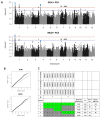Novel Sources of Pre-Harvest Sprouting Resistance for Japonica Rice Improvement
- PMID: 34451754
- PMCID: PMC8401653
- DOI: 10.3390/plants10081709
Novel Sources of Pre-Harvest Sprouting Resistance for Japonica Rice Improvement
Abstract
Pre-harvest sprouting (PHS), induced by unexpected weather events, such as typhoons, at the late seed maturity stage, is becoming a serious threat to rice production, especially in the state of California, USA, Japan, and the Republic of Korea, where japonica varieties (mostly susceptible to PHS) are mainly cultivated. A projected economic loss by severe PHS in these three countries could range between 8-10 billion USD per year during the next 10 years. Here, we present promising rice germplasm with strong resistance to PHS that were selected from a diverse rice panel of accessions held in the International Rice Genebank (IRG) at the International Rice Research Institute (IRRI). To induce PHS, three panicle samples per accession were harvested at 20 and 30 days after flowering (DAF), respectively, and incubated at 100% relative humidity (RH), 30 °C in a growth chamber for 15 days. A genome-wide association (GWA) analysis using a 4.8 million single nucleotide polymorphisms (SNP) marker set was performed to identify loci and candidate genes conferring PHS resistance. Interestingly, two tropical japonica and four temperate japonica accessions showed outstanding PHS resistance as compared to tolerant indica accessions. Two major loci on chromosomes 1 and 4 were associated with PHS resistance. A priori candidate genes interactions with rice gene networks, which are based on the gene ontology (GO), co-expression, and other evidence, suggested that a key resistance mechanism is related to abscisic acid (ABA), gibberellic acid (GA), and auxin mediated signaling pathways.
Keywords: ABA; GA; GWAS; japonica rice; plant hormones; pre-harvest sprouting.
Conflict of interest statement
The authors declare no conflict of interest.
Figures






Similar articles
-
QTL mapping for pre-harvest sprouting resistance in japonica rice varieties utilizing genome re-sequencing.Mol Genet Genomics. 2020 Sep;295(5):1129-1140. doi: 10.1007/s00438-020-01688-4. Epub 2020 May 26. Mol Genet Genomics. 2020. PMID: 32458040 Free PMC article.
-
QTL mapping and improvement of pre-harvest sprouting resistance using japonica weedy rice.Front Plant Sci. 2023 Jun 5;14:1194058. doi: 10.3389/fpls.2023.1194058. eCollection 2023. Front Plant Sci. 2023. PMID: 37342139 Free PMC article.
-
ABA biosynthesis gene OsNCED3 contributes to preharvest sprouting resistance and grain development in rice.Plant Cell Environ. 2023 Apr;46(4):1384-1401. doi: 10.1111/pce.14480. Epub 2022 Nov 26. Plant Cell Environ. 2023. PMID: 36319615
-
Genetic Improvement of Wheat with Pre-Harvest Sprouting Resistance in China.Genes (Basel). 2023 Mar 30;14(4):837. doi: 10.3390/genes14040837. Genes (Basel). 2023. PMID: 37107595 Free PMC article. Review.
-
Pre-harvest Sprouting and Grain Dormancy in Sorghum bicolor: What Have We Learned?Front Plant Sci. 2018 Jun 15;9:811. doi: 10.3389/fpls.2018.00811. eCollection 2018. Front Plant Sci. 2018. PMID: 29963067 Free PMC article. Review.
Cited by
-
Genome-Wide Association Study Reveals Candidate Genes for Root-Related Traits in Rice.Curr Issues Mol Biol. 2022 Sep 21;44(10):4386-4405. doi: 10.3390/cimb44100301. Curr Issues Mol Biol. 2022. PMID: 36286016 Free PMC article.
-
Development and Application of a Target Capture Sequencing SNP-Genotyping Platform in Rice.Genes (Basel). 2022 Apr 28;13(5):794. doi: 10.3390/genes13050794. Genes (Basel). 2022. PMID: 35627177 Free PMC article.
-
Seed Dormancy and Pre-Harvest Sprouting in Rice-An Updated Overview.Int J Mol Sci. 2021 Oct 30;22(21):11804. doi: 10.3390/ijms222111804. Int J Mol Sci. 2021. PMID: 34769234 Free PMC article. Review.
-
RicePilaf: a post-GWAS/QTL dashboard to integrate pangenomic, coexpression, regulatory, epigenomic, ontology, pathway, and text-mining information to provide functional insights into rice QTLs and GWAS loci.Gigascience. 2024 Jan 2;13:giae013. doi: 10.1093/gigascience/giae013. Gigascience. 2024. PMID: 38832465 Free PMC article.
-
Transcriptome and Proteome Co-Profiling Offers an Understanding of Pre-Harvest Sprouting (PHS) Molecular Mechanisms in Wheat (Triticum aestivum).Plants (Basel). 2022 Oct 22;11(21):2807. doi: 10.3390/plants11212807. Plants (Basel). 2022. PMID: 36365261 Free PMC article.
References
-
- Rodríguez M.V., Barrero J.M., Corbineau F., Gubler F., Benech-Arnold R.L. Dormancy in cereals (not too much, not so little): About the mechanisms behind this trait. Seed Sci. Res. 2015;25:99–119. doi: 10.1017/S0960258515000021. - DOI
-
- Black M., Bewley J.D., Halmer P. Encyclopedia of Seeds-Science, Technology and Uses. 1st ed. CABI; Wallingford/London, UK: 2006.
Grants and funding
LinkOut - more resources
Full Text Sources
Miscellaneous

